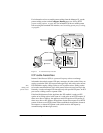
144 Intel NetStructure Cache Appliance Administrator’s Guide
Fine-grained parallelism
The appliance uses a highly parallel application that can manage hundreds of
thousands of concurrent activities by combining kernel multithreading with
an internal scheduling system called Nanothreading.
Raw-disk object store
The appliance stores all cached documents in a custom, high-speed database
called the object store. The object store is a streaming database that supports
storing alternate versions of the same object, varying on spoken language or
browser type.
Alias-free caching
The object store uses content-fingerprinting technology to recognize when
two URL addresses refer to the same content, and shares the content copy in
cache. Thus, the appliance caches identical content only once. The alias-free
cache frees cache space and provides a higher aggregate hit rate for the same
cache size.
Fast space reclamation
A space-reclamation algorithm ensures the appliance collects and removes
stale data. This garbage collection runs continuously and in real time.
RAM caching
To serve popular objects fast and reduce load on disks, the appliance
maintains a small RAM memory cache of extremely popular objects.
Clustering
The appliance uses soft clustering and managed clustering to meet the
performance needs of today and to scale to the needs of tomorrow. You can
increase the Intel NetStructure Cache Appliance performance incrementally
by adding new nodes to the cluster. For more information about clustering,
see Clustering‚ on page 140.
Fast DNS resolver
The appliance includes a fast, asynchronous DNS resolver to streamline
conversion of host names to IP addresses.
Host database
The appliance maintains a database of information about
✔ Internet hosts
✔ DNS information
✔ HTTP versions of hosts
✔ Host reliability and availability information
For information about how you can configure the host database, see Using the
Host Database page‚ on page 44.


















